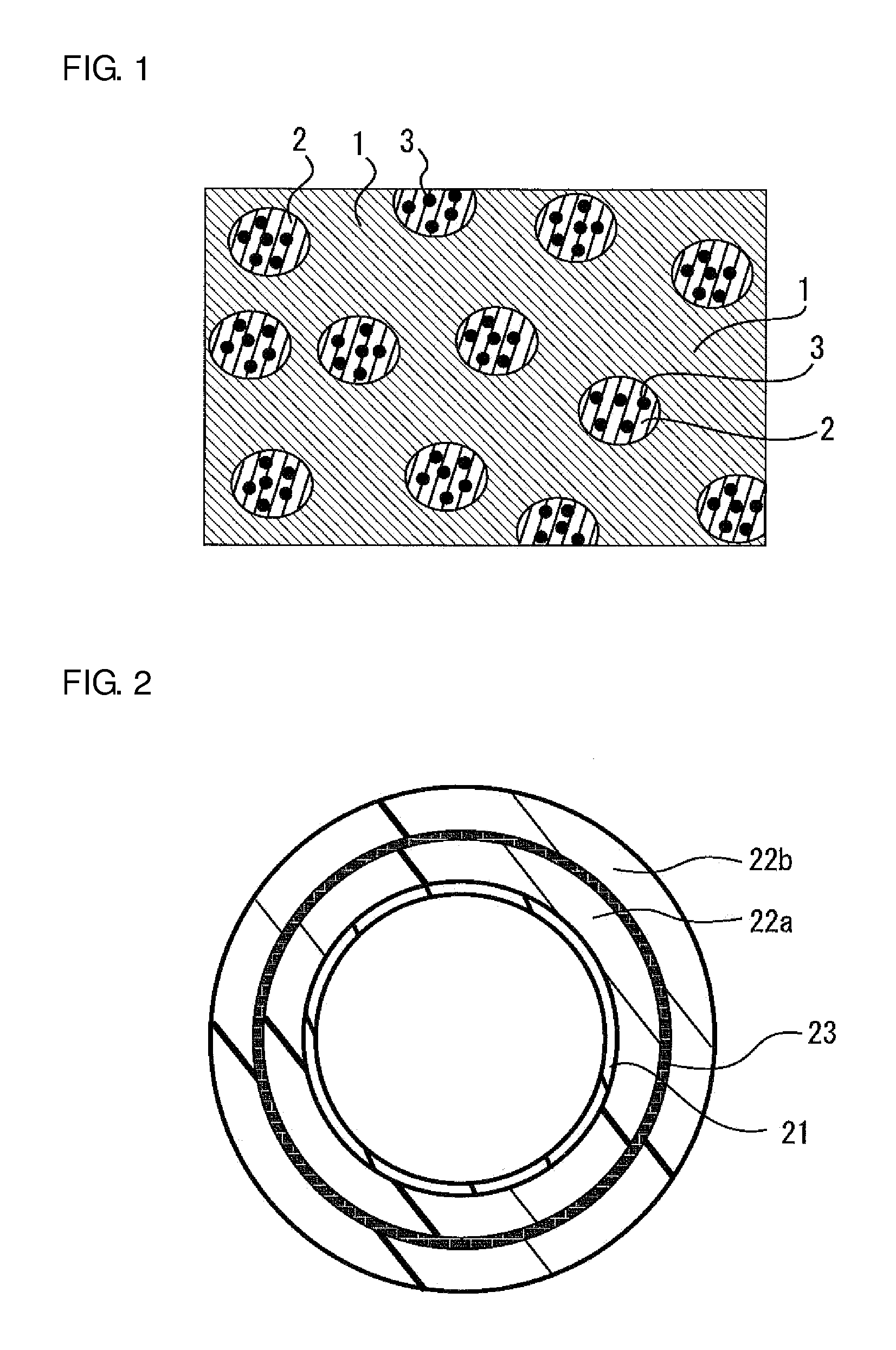Resin composition for refrigerant-transporting hose and method of producing the resin composition, and refrigerant-transporting hose
a technology of resin composition and refrigerant, which is applied in the direction of pipes, vehicle heating/cooling devices, vehicle components, etc., can solve the problems of high rigidity of aromatic polyamide resin, poor flexibility, and deterioration of refrigerant for automobiles, and achieve excellent refrigerant permeation resistance, low crystallization rate, and low crystallization rate
- Summary
- Abstract
- Description
- Claims
- Application Information
AI Technical Summary
Benefits of technology
Problems solved by technology
Method used
Image
Examples
example 1
Preparation of Resin Composition
[0044]A polyamide 6 (PA6) as an aliphatic polyamide resin (Nylon 6 1030B manufactured by UBE INDUSTRIES, LTD.) and an elastomer (modified ethylene-α-olefin copolymer, TAFMER MH7020 manufactured by Mitsui Chemicals, Inc.) were prepared, and were then blended so that the content of the elastomer was 27 wt % of the total amount of the aliphatic polyamide resin and the elastomer. The elastomer was finely dispersed in an uncrosslinked state in the aliphatic polyamide resin by kneading the blend with a biaxial kneader (manufactured by JSW) at 230° C. for 4 to 5 minutes. 10 weight percent of the kneaded product thus obtained and 90 wt % of a PA9T as a semi-aromatic polyamide resin (GENESTAR N1001A manufactured by KURARAY CO., LTD.) were melted and mixed with an extruder (manufactured by Research Laboratory of Plastics Technology Co., Ltd.) at 310° C. Thus, a resin composition was prepared. It should be noted that observation with a scanning probe microscope ...
example 2
[0046]A resin composition was prepared in the same manner as in Example 1 except that: the blending amount of the semi-aromatic polyamide resin used in the preparation of the resin composition of Example 1 was changed to 80 wt % of the total amount of the resin composition; and the blending amount of the aliphatic polyamide resin (kneaded product) in which the elastomer had been finely dispersed was changed to 20 wt % of the total amount of the resin composition. Then, a hose was produced in the same manner as in Example 1 with the resin composition.
example 3
[0047]A resin composition was prepared in the same manner as in Example 1 except that: the blending amount of the semi-aromatic polyamide resin used in the preparation of the resin composition of Example 1 was changed to 70 wt % of the total amount of the resin composition; and the blending amount of the aliphatic polyamide resin (kneaded product) in which the elastomer had been finely dispersed was changed to 30 wt % of the total amount of the resin composition. Then, a hose was produced in the same manner as in Example 1 with the resin composition.
PUM
| Property | Measurement | Unit |
|---|---|---|
| particle diameter | aaaaa | aaaaa |
| temperature | aaaaa | aaaaa |
| temperature | aaaaa | aaaaa |
Abstract
Description
Claims
Application Information
 Login to View More
Login to View More - R&D
- Intellectual Property
- Life Sciences
- Materials
- Tech Scout
- Unparalleled Data Quality
- Higher Quality Content
- 60% Fewer Hallucinations
Browse by: Latest US Patents, China's latest patents, Technical Efficacy Thesaurus, Application Domain, Technology Topic, Popular Technical Reports.
© 2025 PatSnap. All rights reserved.Legal|Privacy policy|Modern Slavery Act Transparency Statement|Sitemap|About US| Contact US: help@patsnap.com

